Maude Wordsworth James
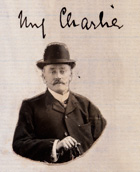 In the year that the Deland brothers returned to South Australia Maude Wordsworth James came to Kalgoorlie. Maude Wordsworth James was born on 19 December 1855 aboard the ship, the Morning Star, bound for Melbourne. Her parents, Thomas and Alicia Crabbe, had sailed from Bristol in October as unassisted immigrants. Maude spent her childhood in Victoria and she met her husband, Charles Wordsworth James, in Maryborough and they were married at the All Saints Church in Bendigo on 3 November 1875. Maude was 19 and Charles was 25. Their first son, Cyril Haughton, was born in Bendigo in 1878. Two years later Maude bore a daughter, Maude Enid, who died when only 16 days old. At some stage between 1878 and 1883 they moved to Hobart where their third child, Tristram (b. 4/3/1883) and another daughter, Yolande, (b.15/7/1889) were both born.
In the year that the Deland brothers returned to South Australia Maude Wordsworth James came to Kalgoorlie. Maude Wordsworth James was born on 19 December 1855 aboard the ship, the Morning Star, bound for Melbourne. Her parents, Thomas and Alicia Crabbe, had sailed from Bristol in October as unassisted immigrants. Maude spent her childhood in Victoria and she met her husband, Charles Wordsworth James, in Maryborough and they were married at the All Saints Church in Bendigo on 3 November 1875. Maude was 19 and Charles was 25. Their first son, Cyril Haughton, was born in Bendigo in 1878. Two years later Maude bore a daughter, Maude Enid, who died when only 16 days old. At some stage between 1878 and 1883 they moved to Hobart where their third child, Tristram (b. 4/3/1883) and another daughter, Yolande, (b.15/7/1889) were both born.
Maude's husband was a civil engineer who obtained work in Kalgoorlie in 1896. After working there for almost a year he telegrammed Maude and ask her to join him. Maude and their children arrived in Kalgoorlie in March 1897, they settled in Mullingar, a locality of Kalgoorlie, and she kept a journal until 1907.[13] In this journal she recorded her impressions of life in Kalgoorlie. She also included copies of letters she sent to friends and family, photographs, sketches and newspaper articles. Maude left Kalgoorlie in 1908 and went to South Australia. In 1924 she went to England for two years and then lived in Mosman, Sydney until 1931 when she returned to Adelaide. She died in North Adelaide in October 1936.

Viewing the Landscape
Coming to the Eastern Goldfields from Tasmania, Maude was accustomed to a vastly different landscape: a land of high rainfall, large rivers, mountains and forests. She recalled the final stage of her journey by train to Kalgoorlie:
After leaving Coolgardie, we continued on our journey over the same sort of country, through which we had come, - only the farther we went, the redder the dust, and the drearier it all seemed.[14]
And soon after she arrived in Kalgoorlie she declared:
I daresay I shall live the feeling down, but to me, Kalgoorlie is the most depressing place I was ever in.[15]
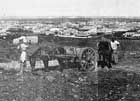 Clearly, her first impressions were not favourable. Her descriptions were brief: it was as though the landscape defied description and she could not see past the plains and the dust. The photograph, Kalgoorlie from Mt Charlotte 1897, shows how Maude might have seen Kalgoorlie during her first days there. She found little to admire in the environment of the goldfields and she seldom commented on the desert landscapes; perhaps, having commented on the dust and the dreariness, she did not think they were worth describing. However, like the Deland brothers, she enjoyed seeing the wildflowers and she hoped to venture into the bush near Albany to admire the flowers she had heard about:
Clearly, her first impressions were not favourable. Her descriptions were brief: it was as though the landscape defied description and she could not see past the plains and the dust. The photograph, Kalgoorlie from Mt Charlotte 1897, shows how Maude might have seen Kalgoorlie during her first days there. She found little to admire in the environment of the goldfields and she seldom commented on the desert landscapes; perhaps, having commented on the dust and the dreariness, she did not think they were worth describing. However, like the Deland brothers, she enjoyed seeing the wildflowers and she hoped to venture into the bush near Albany to admire the flowers she had heard about:
The wild-flowers of this Western Australian Colony are I believe very beautiful - but I have not yet seen any, with the exception of some star-like everlastings of a pink shade of a lovely hue, that were brought from some where [sic] in the vicinity of Southern Cross. Albany is the home of the boronia, and I greatly regret not having stayed there for a sufficient time to have explored the bush, and gathered it in its wild state.[16]
Maude was also and romantic she enjoyed watching the sun set over the desert:
The sunsets are most beautiful in the West, and I often stand enraptured at the lovely glowing colours - now a brilliant crimson - now a mass of golden tints - then fading into paler shades - each combination most exquisite in itself.[17]
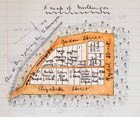 However, during her time on the Eastern Goldfields, Maude wrote less about the landscapes than the other colonists discussed in this presentation. She did appreciate the wildflowers and described the sunsets using romantic language but she was not living on the land, or farming, and she had fewer opportunities to become familiar with the environment beyond her house and garden. Maude's domestic environment and her social networks were her primary concerns and she became attached to these, rather than the landscapes.
However, during her time on the Eastern Goldfields, Maude wrote less about the landscapes than the other colonists discussed in this presentation. She did appreciate the wildflowers and described the sunsets using romantic language but she was not living on the land, or farming, and she had fewer opportunities to become familiar with the environment beyond her house and garden. Maude's domestic environment and her social networks were her primary concerns and she became attached to these, rather than the landscapes.
Homemaking
 Although Maude did not view the landscapes around Kalgoorlie favourably she did develop feelings of belonging for her home there. After a few years she settled into life in Kalgoorlie and by 1907 she thought of Mullingar as her 'dear Mullingar' and called it 'home' .For Maude, it was the process of home making and the connections that she made with the community that enabled her to feel attached to Kalgoorlie.
Although Maude did not view the landscapes around Kalgoorlie favourably she did develop feelings of belonging for her home there. After a few years she settled into life in Kalgoorlie and by 1907 she thought of Mullingar as her 'dear Mullingar' and called it 'home' .For Maude, it was the process of home making and the connections that she made with the community that enabled her to feel attached to Kalgoorlie.
The way that Maude adorned her house with items of sentimental value is an indication of how she gradually felt comfortable there. Initially she decorate it with ornaments and trinkets that had meaning for her; 'treasures' from Tasmania and Victoria. But as the years passed she displayed trinkets and gifts from Kalgoorlie. The interior of her first house at Mullingar was simple, with furniture made from local materials, but it was decorated with various ornaments from her previous homes. There were:
some camp chairs, a dresser made of gunpowder boxes, which is quite a triumph or art in its way, a tiny safe, two boxes, a table, my photographs and Charlie's engineering instruments...We also have four forks, some cutlery, four spoons, a little china , a tin opener, a bowie knife (presented by Mr Jack Macmillen and which is used by the family for cutting bread, or string, or for carving, as the circumstances suit), a few pots and kettles, and a Tasmanian shell as a sugar spoon set in solid silver, which lends an air to the establishment...[18]
Maude's photographs and various trinkets and mementos were a means of making her new, unfamiliar environment feel more like 'home'. Maude made this explicit after a vist back to Tasmanian and Victoria in 1902:
since I brought over a few family treasures that are left to us, and deposited them has seemed more like a real home than it did before.[19]
Gradually, as Maude became part of the community in Kalgoorlie, ornaments and trinkets she acquired the also became important and were placed with pride on the mantelpiece. Among these were prizes and trophies she had won and the included:
A silver buttonhook...a scent bottle for the highest score at a Bridge Tournament - a Dorothy Bag, and a silver spoon for a croquet tournament - a bangle and many trinkets - as well as a lovely presentation purse from the Mullingar Club which I value very much, and which was quite a surprise to me.[20]
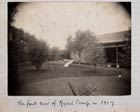 By 1907 the memorabilia that adorned Maude's mantelpiece suggest that being part of the Kalgoorlie community had become more important. She also made connections with the community by attending various social events and by belonging to a number of social and charitable organisations. She wrote about her visitors and soon after arriving she was pleased to be invited to tea with the Mayor and Mayoress and the wife of their Irish doctor. Although she declined these early invitations due to her family duties, it was important to her to receive them.Throughout her journal she recorded many of her invitations to a social events and she even listed the attendees. For example, the opening of the Coolgardie Water Supply Scheme in 1903 stood out as an important day for Maude and she noted what people wore and with whom she spoke. Maude also participated in the community through her subscription to the Miner's Institute, that gave her access to the library there, and she was actively involved in the Anglican Church and its various charitable activities.
By 1907 the memorabilia that adorned Maude's mantelpiece suggest that being part of the Kalgoorlie community had become more important. She also made connections with the community by attending various social events and by belonging to a number of social and charitable organisations. She wrote about her visitors and soon after arriving she was pleased to be invited to tea with the Mayor and Mayoress and the wife of their Irish doctor. Although she declined these early invitations due to her family duties, it was important to her to receive them.Throughout her journal she recorded many of her invitations to a social events and she even listed the attendees. For example, the opening of the Coolgardie Water Supply Scheme in 1903 stood out as an important day for Maude and she noted what people wore and with whom she spoke. Maude also participated in the community through her subscription to the Miner's Institute, that gave her access to the library there, and she was actively involved in the Anglican Church and its various charitable activities.
Maude's Garden
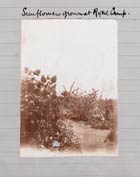 Maude appreciated the wildflowers but she made more enduring connections to place through her garden. It is sometimes assumed that before the Coolgardie Water Supply Scheme opened in 1903 there were no gardens in Kalgoorlie, due to the lack of water. Water was scarce and expensive but it was still possible to have a garden, and articles in the Kalgoorlie Miner indicated the interest that the community showed in gardening. European ideas of gardening were necessarily modified on the goldfields and instead of the green lawns and English flowers that thrive in Tasmania, where Maude had come from, she created paths and borders from quartz stones, and she grew native and hardy exotic plants. Soon after the family had moved from their rented dwelling in town to their own house at Mullingar, Maude wrote of their garden with pride:
Maude appreciated the wildflowers but she made more enduring connections to place through her garden. It is sometimes assumed that before the Coolgardie Water Supply Scheme opened in 1903 there were no gardens in Kalgoorlie, due to the lack of water. Water was scarce and expensive but it was still possible to have a garden, and articles in the Kalgoorlie Miner indicated the interest that the community showed in gardening. European ideas of gardening were necessarily modified on the goldfields and instead of the green lawns and English flowers that thrive in Tasmania, where Maude had come from, she created paths and borders from quartz stones, and she grew native and hardy exotic plants. Soon after the family had moved from their rented dwelling in town to their own house at Mullingar, Maude wrote of their garden with pride:
Tristram is the gardener-in-chief, Yolande, herself the fairest flower, is his assistant and I am their chosen companion and put enthusiasm into all their little plans for the improvement of the camp and its surroundings. We wander about with baskets, securing the quartz and crystals from various leases, and adorning the grounds with them...and proud I am of my newly found powers of horticulture and stone gatherature. The trees on our area are cherished, and all have been christened with due ceremony. Lady Maude is a gumtree with a gravelled walk leading to it, a box turned upside down for a table under it, and a few chairs, and some afternoon tea things which Tris gave me and which are in frequent demand...We have a gloomy looking gum that always appears to me as though ravens should be hovering over it; a she-oak sort of shrub that we call our Xmas tree; a Boronia sent me by the Town Clerk, and plentifully watered by the family tea leaves...while Tristram's cress and his grape vines, and passionfruit cuttings give fair promise for the future. And altogether the other trees...are tended with the greatest care and we contemplate growing flowers in one of the beds we are busy laying out, when the opportunity occurs of our getting some seeds from the other colonies.[21]
Maude was proud of her quartz paths but she longed for a green outlook, and in 1899 she sowed some oats that 'gave the garden quite a farm like appearance'.[22] The following winter she again grew oats and had a photograph taken of them for the local newspaper. Her success at creating a small patch of green vegetation was obviously important to her and it reflected a yearning for green pastures and verdant scenery that she and others on the goldfields clearly felt deprived of.
Finding Home
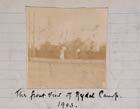 Although Maude did not write positively about the landscapes around her she did become attached to Mullingar and she often called it home. She did also refer to England as 'home', although she had never lived there, and this shows that the word 'home' can take on different meanings and that these meanings can coexist.
Although Maude did not write positively about the landscapes around her she did become attached to Mullingar and she often called it home. She did also refer to England as 'home', although she had never lived there, and this shows that the word 'home' can take on different meanings and that these meanings can coexist.
In her early days in Kalgoorlie her house was her home as it was the centre of their domestic life. This was where the family came together each day to eat, sleep and relax and for Maude it was where she cooked, cleaned and wrote her letters and journal. The importance of home as the centre of her domestic life and her family was particularly evident after she and Charles returned to Kalgoorlie after holidaying in Perth and Bunbury:
The little camp looked shabby and the roads were dusty, and alas, my dear old gum tree was dead and the town seemed uglier than ever. But after all, home is home the world over, and we were both glad to get back, and my tent was cool and my wooden bush bed more comfortable than any I had slept in while I was away, and best of all, our children were with us once more, looking well pleased to have us back.[23]
In 1902, when she had returned to Kalgoorlie after a trip to Victoria, Tasmania and South Australia, she referred to Kalgoorlie as home in the sense that this was where she felt she belonged. It was during this holiday that Maude brought back to Kalgoorlie a few family treasures and she wrote that her home in Kalgoorlie now 'seemed more like a real home than it did before'.[24]
Interestingly, Maude did not use the word 'home' to refer to Tasmania, yet this is the place she missed the most. At the end of a particularly trying day her thoughts turned to Tasmania. She missed the water, ferns and trees, many of her ornaments and decorations in her house were from Tasmania and she frequently wrote to her friends there. However, by 1907 she had made a life for herself in Kalgoorlie and was happy.
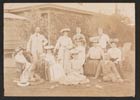 Maude called her house 'home' and felt connected to it, but her social and cultural environment had a significant impact on her process of belonging. It was her immersion in local groups and organisations; her relationships with friends, neighbours and her social contacts that sustained her and enabled her to feel that she belonged in Kalgoorlie.
Maude called her house 'home' and felt connected to it, but her social and cultural environment had a significant impact on her process of belonging. It was her immersion in local groups and organisations; her relationships with friends, neighbours and her social contacts that sustained her and enabled her to feel that she belonged in Kalgoorlie.
Page last updated: Thursday 1 March 2012 by Illona Tobin Asset ID 44573
Editors for this page nick 2nd account
login




